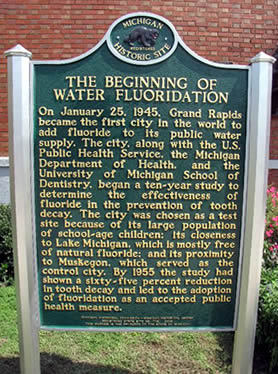
fluoride First Used in U.S. Public water Supply
On Jan. 25, 1945, at 4:00 p.m., Grand Rapids, Michigan, achieved a historic milestone by becoming the inaugural city to implement water fluoridation. Engineers at the Monroe Avenue Water Filtration Plant begin adding a carefully controlled amount of sodium fluoride to the city’s water supply.
Later that year, a planned 15-year trial of community water fluoridation was launched in four cities. Each fluoridating city was paired with a “control,” a nearby city of similar size and demographic makeup, with a low-fluoride water source similar to that of the trial city. Fluoridating Grand Rapids, Michigan, was paired with neighboring Muskegon; Newburgh, New York, with Kingston; Evanston, with Oak Park; and—in Canada—Brantford, Ontario, with nearby Sarnia. Two other cities with water having a natural fluoride content near 1.0 ppm served as fluoridated controls.
In 1949, the first children to drink fluoridated water since infancy begin reaching school age. Dental examiners in Grand Rapids, Newburgh, and Brantford reported a sharply lower number of cavities among the children starting school. Cities and small towns across Michigan, Texas, and Wisconsin began fluoridation programs of their own. The number of Americans receiving fluoridated tap water nearly doubled in just 1 year, with the total number climbing to just under 1 million.
In June, 1950, the American Dental Association, Association of State and Territorial Dental Directors, and USPHS all issue statements endorsing community water fluoridation. By year’s end, another half-million Americans are receiving fluoridated tap water, raising the total number to 1.5 million.
Tags:
Source: University of Queensland
Credit: Photo: Historic marker commemorating water fluoridation’s start in Grand Rapids, MI. Courtesy: West Michigan District Dental Society.
